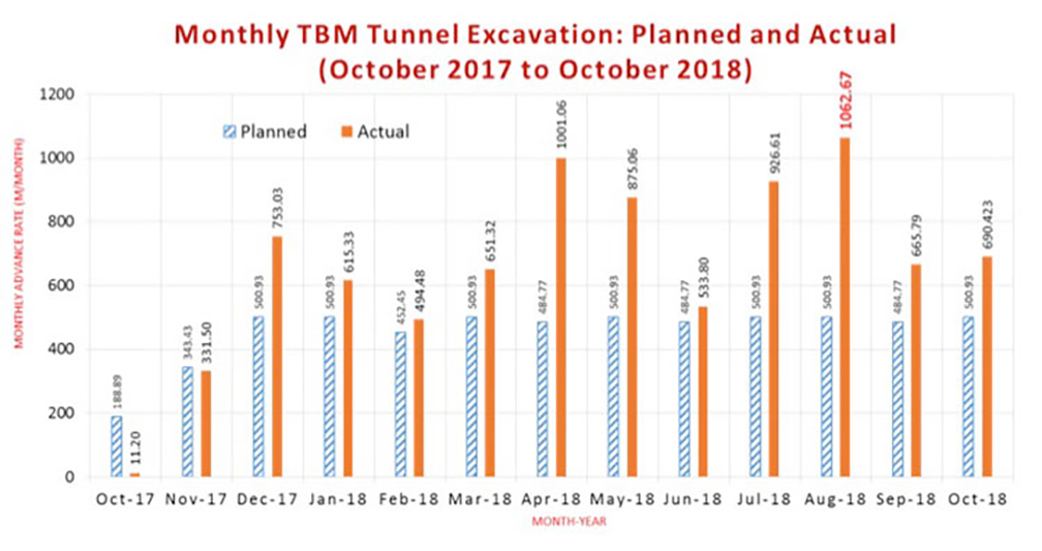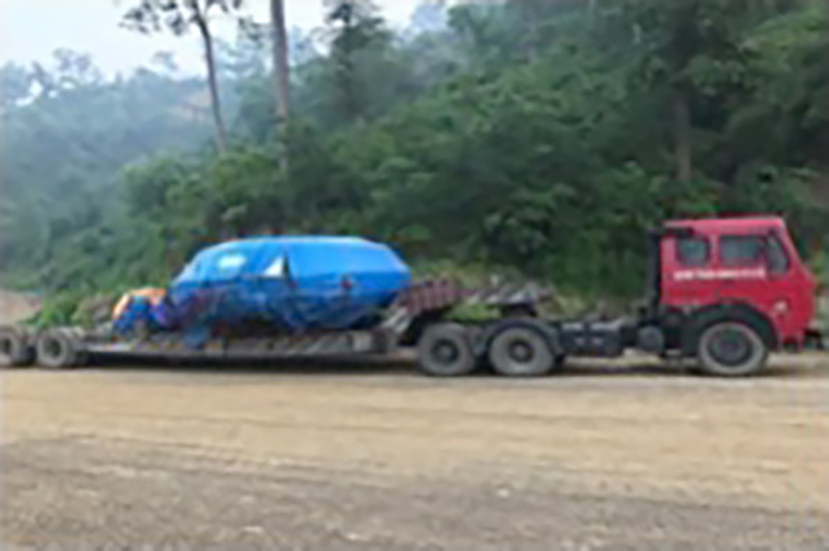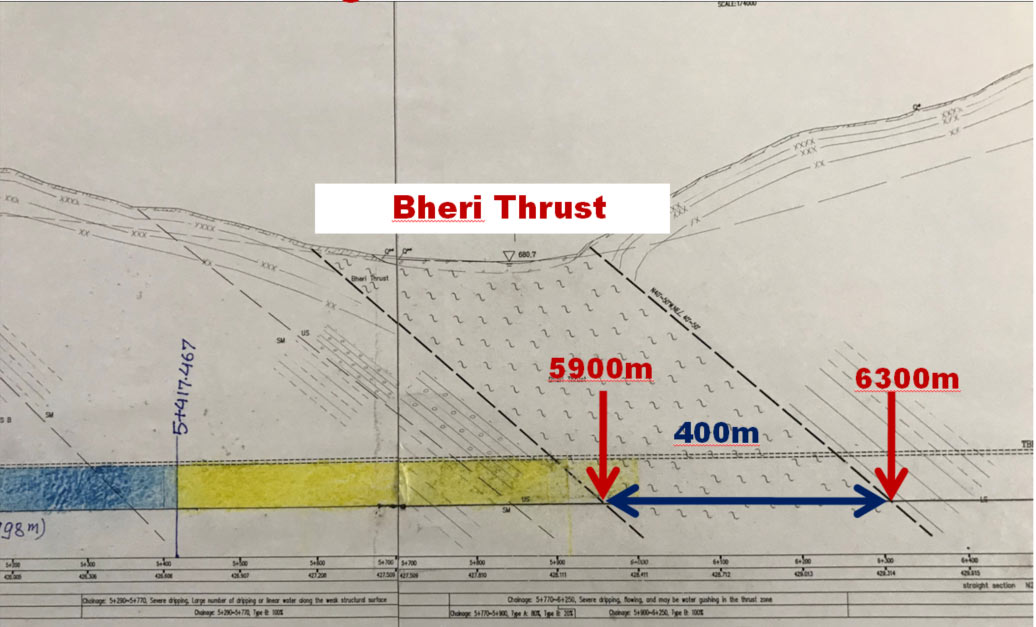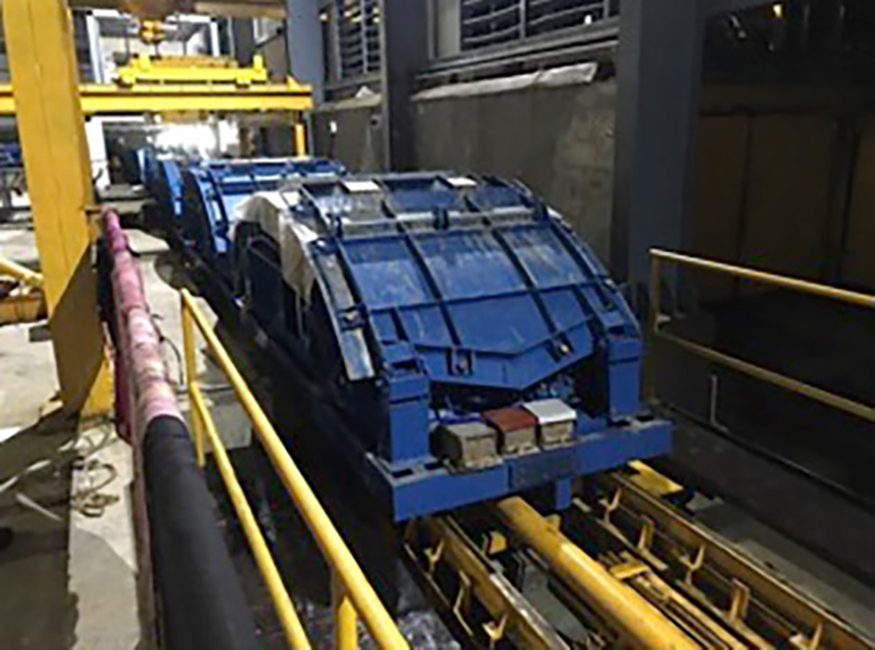Early breakthrough in Nepal for Bheri Babai 25 Apr 2019
After an impressive drive through geological challenges in the Himalayas, breakthrough has been achieved a year ahead of schedule for the 12.2km Bheri Babai multipurpose water conveyance TBM drive in western Nepal. The 5m diameter TBM from USA manufacturer Robbins made the breakthrough for contractor COVEC, the China Overseas Engineering Company, on April 16.

Nepal Prime Minister KP Sharma Oli (centre) officiates at the TBM breakthrough with COVEC Project Manager Tianran Hu (left) and Project Director Sanjeeb Baral for the Nepal Department of Irrigation
Predictions for the TBM through the young geology of the Himalayan foothills, was progress of 400-450m/month to complete the 12.2km long drive in 26-30 or more months. The well-managed operation of the robust and well-prepared TBM completed the drive through fortunately favourable sandstone and mudstone in 18 months. The double-shield TBM, erecting a hexagonal segmental lining in its wake, recorded up to more than 1,000m/month, working two x 12hr shifts/day, seven days/week.
As the first TBM drive in Nepal, the inter-basin water transfer project attracted significant national and international attention. The breakthrough on the bank of the Bheri River was officiated to great celebration by Nepal Prime Minister KP Sharma Oli, and was attended also by Chinese Ambassador to Nepal, Hou Yanqi, and USA Ambassador to Nepal, Randy Berry.
"Nepal is now ready to walk and work together with the international community towards the new direction of development," said Prime Minister Oli, who expressed gratitude to the Chinese contractor and a desire to use new technology for future projects.
Breakthrough of the 12.2km tunnel marks completion of the first TBM drive in one of the world’s least developed countries. The US$107 million project will provide irrigation for 51,000 hectares of land and secure fresh water supplies to the western Napal town of Nepalgunj.
Minister for Energy, Water Resources and Irrigation, Barsha Man Pun, said that this early breakthrough would inspire TBM use on other projects.
The multipurpose irrigation-hydro project is one of many strategic projects in Nepal. In phase two of the project, a 48MW hydro power plant is due to be built.
References
- Nepal proving TBM applicability in Himalayas – TunnelTalk, February 2019
- Urgent infrastructure needs in Nepal – TunnelTalk, November 2018
- First TBM for Nepal ready for shipment – TunnelTalk, August 2017
- Impressive progress for first TBM operation in Nepal – TunnelTalk, July 2018
Of all the mountain ranges of the world, the Himalayas hold the greatest degree of doubt for tunnel and underground excavation projects. The geology is young, conditions highly unpredictable and opportunities for geological investigation limited, if not impossible. Open face drill+blast and excavator excavation is, and has, therefore, been the preferred or specified method. Attempts at TBM mechanical excavation have had unhappy experiences in the Himalayas with machines becoming trapped, progress painfully slow through either very hard tough rock prone to rock bursting, or through flowing soft gouge in extensive fault zones, and battling through high groundwater inflows under high heads of pressure.
For the 12km long Bheri Babai water transfer tunnel near the town of Nepalgunj in the south west of Nepal, these considerations kept the project in discussion for years, the main problem being there is no possibility of opening multiple adits along the alignment. Any method of excavation could progress from the portals only. An open face drill+blast operation from both portals would take up to 10 or 12 years to complete. TBM excavation would go faster but would carry the high risk of the machine becoming stuck on several occasions and for several weeks or months in likely zones of squeezing, flowing, highly fractured and unstable conditions.
Finally, in 2015, the urgent need to divert water from Bheri River of abundant supply to the Babai River of high demand and insufficient supply forced the decision by officials of the Department of Irrigation to advance the project - and to advance it as a TBM operation.
COVEC, the China Overseas Engineering Company, as the lowest responsive bidder, was awarded the US$93 million (ex VAT) contract to excavate the 12km x 5.06m o.d. tunnel, against competition from the Seli Overseas of Italy, CMC of Italy, Sino Hydro of China and HCC of India. The TBM selected for the segmentally lined tunnel is a Robbins double-shield TBM.
“For me, the start of the project was the end of a long road of support and promotion by Robbins, and our advocacy of a TBM application even in the face of the risks - which we recognised were considerable,” said Binaya Man Shrestha, Country Manager of The Robbins Company, Nepal. “As representative of The Robbins Company since 1990, our first promotion of a TBM application was for the Arun III hydroelectric scheme but the effort failed and the project was cancelled in 1993 following withdrawal of World Bank financial commitment.” The Arun III project has finally commenced construction in 2018 using drill+blast for the 11.8km long x 9.5m diameter headrace.
The use of a TBM for the Bheri Babai was confirmed after extensive detailed studies and research on the technical and economic feasibility of a TBM operation for the project and after consultations with TBM experts from Robbins, Herrenknechkt, Mott McDonald, Babenderede Engineers, Jaeger Bau, the China Gezhouba Group and others. Former Director General of the Department of Irrigation, Shiv Kumar Sharma; Former Director General, Madhav Prasad Belbase; Former Project Director, Shiv Kumar Basnet; and Former Project Geologist, Ajay Raj Adhikari were among the key architects who believed in a TBM application and the need to take the ‘great step forward’.
The Robbins machine was assembled and tested in China before being shipped to arrive by sea at the port of Kolkata, India. From there it was transported by a convoy of 56 trucks to the job site, the largest component being the 5m diameter main-bearing and drive unit at some 67 tonne, for transport. As well as upgrading certain sections of road to the site, Nepali officials worked with Indian officials to secure permissions and safe passage of the TBM convoy to the project site about an hour’s drive from Nepalgunj, the border town with India in the west.
“The National Pride status of the project was appreciated by the Government officials in Nepal and their counterparts in India and everything went smoothly,” said former Project Director Basnet. “It took 21 days from Kolkata to Nepalgunj, and three days from Nepalgunj to Babai, including a 12 hour closing of the highway overnight to get the convoy to the job site.”
The TBM is purchased for the project and is fully owned by COVEC. It has been imported into Nepal on a re-export basis and on payment of the 1% concessional import duty. If the TBM is retained in Nepal, or sold to a third party in Nepal, it will be subjected to the applicable 10% import duty and the 13%VAT.
Advisor to the project for construction supervision and monitoring is Geodata of Italy, which has been part-owned by China Power Corporation since mid-2017. Arun Kumar Sharma, Deputy Team Leader for Geodata on site, emphasised that the company is not The Engineer for the FIDIC based contract, but rather a technical consultant, providing also consultancy for geology and geotechnical issues on the project.
Site establishment
“We came to the site in June 2016,” explained Hu Tianran, Project Manager on site for COVEC. “After constructing the access roads to the job site and building the offices and resident camps for us and also for the owner and project consultant, we set about establishing the segment casting factory, the access working platform and the deep cut required to establish the working portal at the downstream end of the 12km long tunnel. The TBM arrived in September 2017 and, after its assembly in a record 21 days, we celebrated its launch in October.”
“On the site we have 45 Chinese engineers in technical and management roles and we have trained crews of more than 2,000 local Nepali nationals for the tunnelling works and the segment casting factory,” said Hu. Among the Chinese nationals is Foreman Jin Haikuan who speaks fluent Italian, having worked for five years with Italian contractor Impregilo on the Kárahnjúkar hydro scheme in Iceland from 2004 to 2009. While there he became TBM foreman and learned his TBM operation and maintenance skills on the three Robbins machines used to complete the project’s 60km of exacting hard rock TBM excavation. At Bheri Babai, Jin is TBM Manager and is constantly at his office console at the tunnel portal that relays to screens the operating parameters and cctv monitoring cameras. Jin and his team limited the need for Robbins field service personnel, running also an efficient cutter and tool maintenance and repair workshop on site.
To begin with, there was caution as the TBM made its first meters into the mountain. The ridge dividing the rivers rises above the alignment of the TBM drive to more than 820m and while the start of the slight up gradient TBM drive was in sedimentary sandstone, the caution was for unexpected fault zones, fractured zones of high water ingress under high pressure, rock bursting and squeezing, and in particular, an identified thrust zone of up to 400m wide at 5.6km into the drive.
To cope with anticipated ground conditions, the double shield TBM has a gauge cutter diameter of 5.06m and a shield taper from 4.99m at the front to 4.91m at the back, providing an annulus around the hexagonal segmental lining of 7-13cm. It has six VFD drive motors for an installed power of 3,027kW and a maximum trust of 20,826kNm. The cutterhead is fitted with 33 x 17in cutters and has a rotation of up to 11.4 rev/min. Maximum torque on the cutterhead is 3,475kNm.
Pea gravel is injected into the annulus and consolidated with mortar with a pass of secondary grouting ensuring all voids are filled. The lining joints are also filled to ensure a smooth surface for efficient water flow to the 48MW hydro plant on the conveyance project.
Segment lining design
The segmental lining has two design types – first a more lightly reinforced, non-bolted design for reaches through good rock conditions and secondly, a bolted design, with additional reinforcing rebar and two bolts, one on each angled edge of the hexagonal segments for four bolt pockets per segment, to line the water tunnel through anticipated reaches of unstable and faulted conditions.
The rebar cages are fabricated on site, from steel supplied from Jagdamba Steel, Nepal. Concrete is batched on site from cement supplied in bags by Nepal suppliers Ghorahi Cement and Shivam Cements of Nepal. While the bagged cement is serving the purpose, it carries a degree of waste and is a health hazard for the workers handling the cement into the batching plant hoppers. This is unavoidable however, as there is no bulk cement supply alternative, and is one of few downsides of the whole set-up, which presents to visitors as a highly efficient, well organised, professionally managed operation by Project Manager Hu. Presence of the construction process appeared well integrated also into the local community with several arrangements negotiated with community leaders including a new location for muck disposal, to avoid trucks travelling through the village, and the use of tunnel muck to restore the river course after devastating floods in Nepal in 2017.
Segment lining design
When excavation started, the first 1,000m was completed in 1.7 months; the second 1,000m in 1.8 months, and across the first eight months, 5.4km had been completed. “Not only we, but most observers of this project were waiting for our TBM to get stuck or for progress to slow dramatically,” said Hu, “but it did not. The geology remained favourable in good quality sandstone and mudstone, not very hard and not very abrasive, and we began recording advance rates of more than 800m per month - more than double the anticipated rates at the beginning.”
Everything was going well. The TBM crews - working 2 x 12-hour shifts/day, 7 days/week, with one day off at shift pattern change every two weeks - had advanced well through the learning curve and the TBM was achieving maximum operating time, minimal downtime and little time for maintenance and tool changes. In November 2018, when TunnelTalk visited the site, Hu explained that there had been only six sets of the 33 x 17in cutters changed across more than 9km of tunnelling, that there had been no major encounters of progress-slowing ground conditions, and that the excavation had settled into a routine rhythm. Muck hauling and segment supply trains of 9 x 10m3 rota-dumping skips and 2 segment cars work on a two-ring, or two 1.4m long TBM stroke, cycle with one California switch installed at the 6km mark and another California on the TBM backup.
Good progress is also enabled by operation of the machine in its double-shield mode with the rock providing efficient foundation for the grippers in the forward shield to provide forward excavation while ring building continues in the rear ring-build shield. Avoiding the need to stop TBM excavation to build each ring - as is required with single shield machines that require forward thrust off the segmental lining - is a major contributor to the impressive advance rates at Bheri-Babai. These rates called for a change in the segment lining sequencing.
Of the two segmental lining designs, 94% of the production was for the non-bolted, lighter reinforcement design for good rock conditions, and 6% was for the heavier bolted design required in anticipated bad ground. As it happened, more of the lighter design was required, but with none available, the greater stock-pile of heavier bolted design segments had to be used in reaches of good ground, minus inserting the bolts and backfilling the bolt pockets by the inner lining finishing crews.
But there was still the identified thrust zone of bad ground ahead to get through and as luck and good fortune had it, this also proved benign. There was a no-show of the enormously challenging conditions that everyone expected through the 400m or so of the thrust zone. “We were through the zone without any change in our normal 30m/24hr day routines,” said Hu.
The one section of poor ground was encountered about two weeks before the TunnelTalk visit. A section of soft material ran at the face, clogging the cutterhead and excavation. A 6.5m high x 0.7m wide shotcrete-supported passage along the outside of the shield was needed to gain access to the front of the TBM to stabilise the material around the machine and allow its advance into more stable conditions. A programme of post secondary chemical grouting was also required to control subsequent water ingress.
Since the visit in late November 2018, progress has advanced the heading to 11km and all has continued to move forward well despite now being in the last 2km of harder, 40MPa sandstone rock. TBM rates have slowed to an average of 25m/24hr day or 175m/7 day week but the built-in power and robust design of the TBM is allowing for steady predictable advance. With less than 1km now to finish, breakthrough at the intake end of the tunnel is due by mid-March. Construction of the TBM reception platform for breakthrough and disassembly is well advanced.
Predictions for the future
The Bheri-Babai project has been a revelation. It has confounded those who predicted tough times for the TBM in the foothills of the Himalayas and it has caught the project owner in somewhat of a fortunate but embarrassing situation. The expectation of 400-450m/month for TBM progress and expected holdups of weeks, if not months, in zones of bad ground, influenced the scheduling of other parts of the water conveyance project. As such the contracts for intake and the outlet works into the receiving river are yet to be awarded. With the tunnel completed up to a year earlier than expected, it is likely to stand completed and not used for a year or two while other parts of the project catch up.
“Awarding the intake and the surge shaft and hydro powerhouse and outlet contracts is something we are working on now,” said Sanjeeb Baral, current Project Director. “The two contracts are being prepared for a tender process in early 2019 and for contract award and start of construction by mid-2019.” Director Baral joined the project in 2018 and took over from Shiv Kumar Basnet in September as the fully engaged Project Director. He has been instrumental in accelerating procurement of the remaining works and completing the project.
All officials associated with the project are extremely pleased with the performance at Bheri-Babai. Officials associated with the Melamchi water supply tunnel in Kathmandu, that has taken 6.5 years to excavate a smaller tunnel of 3m diameter and 21km long using drill+blast from the two portals and in both directions from three intermediate adits, are envious. But everyone knows that not all tunnelling projects can be expected to fair so well. International TBM excavation experts are also advising caution, but it is now optimistic caution rather than the pessimistic caution of earlier times, and the lessons for a successful TBM operation in the Himalayas from the experience are several.
First of all, contractors must send the A-team to projects that are likely to be difficult. The C or even the B-team will not do. Had the Bheri-Babai project turned out to be as difficult and problematic as anticipated, Manager Hu would have been the right man there to manage the situation. His management and the establishment of his site and excavation operation with the rest of this A team colleagues is clearly recognised as a major part of this success. The shortfalls of a less able manager would have been as clearly evident.
Manager Hu also demonstrated skills during the visit when in meetings with managers and representatives of the owner and the consulting engineering advisers that any conflicts or disputes or contractual issues could be expected to be, or have been, resolved professionally and without contention. Since the project is advancing faster than expected, the contractor is making money and the potential for dispute are few, but the A-team of a contractor will make even the most difficult jobs get through. A lesser team can make the most straightforward of projects contractually contentious. And it is for the contactor’s team to have these skills, as it is the contractor that has to get the job completed successfully. It is the contractor’s A-team project manager who will have to succeed in negotiations with the owner and the consulting engineer, no matter their level of negotiating and management skill. It is the contractor’s team that will get turned out first if a project is running into difficulties.
As an example, when asked if the consulting engineering team was happy with the work done to consolidate the zone where the TBM had become stuck, Manager Hu said: “They are never 100% happy” and that too is their job.
When asked about his next move, Hu said that it may not be in tunnelling. “I studied civil engineering at the SouthWest University in Chengdu and my early experience was on soft ground TBM tunnels for the Chengdu Metro. This is my first job overseas and my first hard rock tunnel experience. After this job, I will go wherever I am sent and that might be to a bridge project, but my expanded experience with this project, is in tunnelling and I like this sector of civil engineering.” Hu’s proficient English as a second language, he said was honed on the Bheri-Babai project. “I had not used my education English very much before coming to Nepal and all communication here, with the partiers, the TBM supplier and the workers is in English, so it has been a good learning experience in that regard as well.”
Next, pick the right equipment. Hu explained that he had insisted on all new equipment with his managers. There would be no cast-offs of old, tired equipment to cause downtime and maintenance delays. When asked about the Robbins TBM he said that he expected it would be a Chinese manufactured TBM but that he respects the Robbins TBM and its abilities. “It is a powerful and robust machine and has caused us no maintenance or operation problems of significance,” he said. “We have not needed sustained support from Robbins but when we have required their input it has been immediate and without complications. Spare parts supply and other communications have all been a positive association.”
Finally, there has to be the money available for project progress, and this is the case with Bheri-Babai. The 10.56 billion Nepal Rupee (US$107 million) cost of the tunnel contract (including applicable taxes in Nepal) is being fully financed by the Nepal Government by itself. There are no funding arrangements with donor countries or international banking institutions. It is a high profile project for the international tunnelling industry and a prestigious National Pride project for Nepal. As a result there is no hold up of progress payments to the contractor. A project experiencing progress difficulties and being starved of cash flow progress payments can be the start of the spiral down to acrimonious and long lasting dispute.
For Nepal, for the international tunnelling industry, for the many projects needing to be completed in the countries of the Himalayas, Bheri-Babai is a major success and will be a benchmark reference project for all future tunnel excavation projects to be built in the mountain massifs of the world - a true win-win-win undertaking.
References
- +60km of tunnelling for Iceland’s Kárahnjúkar power station complete – TunnelTalk, April 2008
- Urgent infrastructure needs in Nepal – TunnelTalk, November 2018
- Impressive progress for first TBM operation in Nepal – TunnelTalk, July 2018
- Landslide hits tunnel portal at Arun-3 in Nepal – TunnelTalk, July 2018
|
|
|
|
|
Add your comment
- Thank you for taking the time to share your thoughts and comments. You share in the wider tunnelling community, so please keep your comments smart and civil. Don't attack other readers personally, and keep your language professional.














